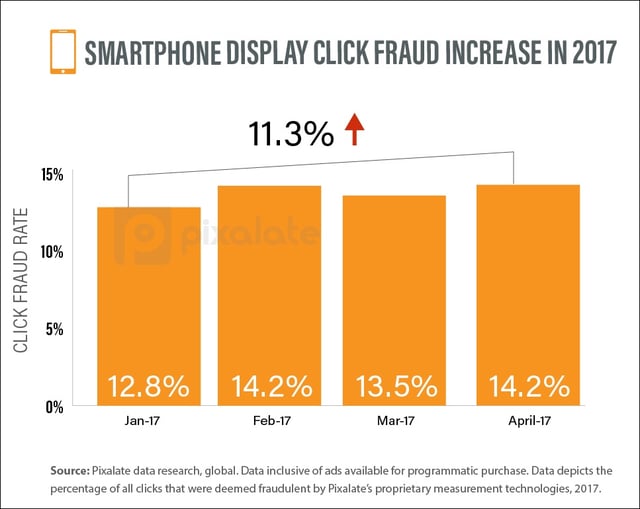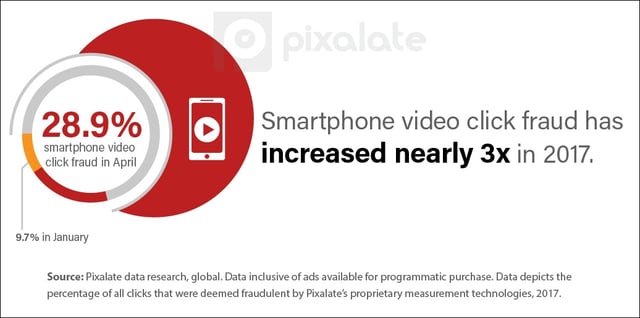
Continuing our series examining programmatic click fraud metrics to identify trends, patterns, and key takeaways, Pixalate today looks at smartphone click fraud rates from the first part of 2017. Mobile click fraud remains an issue for programmatic marketers — so how does it impact smartphones specifically?
If you want to know what a "mobile click farm" looks like in action — check out this article from Daily Mail.
Smartphone display click fraud — across web and apps — increased slightly during the first four months of 2017.

Marketers who rely on click data in the mobile ecosystem need to be aware of trends like this. The rise from 12.8% to 14.2% over the course of four months may seem insignificant, but it does represent an 11.3% increase in a relatively short period of time. The issue of click fraud can quickly snowball.
While smartphone display click fraud saw a marginal increase (11.3%) in click fraud over the first several months of 2017, the picture wasn't quite as rosy for smartphone video ads.

As you can see, video ad click fraud in mobile is an evolving, often volatile problem. From January-April, video ad click fraud rose about 3x. But within that span, it increased by as much as 5x (in February).
Fraudsters are constantly changing their click fraud tactics. As we saw in the click farm video shared by Daily Mail, there are dedicated "centers" out there meant solely to fake clicks on mobile devices.
Marketers who focus campaigns on PPC and CPC opportunities in mobile need to structure those campaigns around click fraud, because our data indicates that the risk associated with these campaigns is both volatile and growing.
*By entering your email address and clicking Subscribe, you are agreeing to our Terms of Use and Privacy Policy.
These Stories on Mobile
*By entering your email address and clicking Subscribe, you are agreeing to our Terms of Use and Privacy Policy.

Disclaimer: The content of this page reflects Pixalate’s opinions with respect to the factors that Pixalate believes can be useful to the digital media industry. Any proprietary data shared is grounded in Pixalate’s proprietary technology and analytics, which Pixalate is continuously evaluating and updating. Any references to outside sources should not be construed as endorsements. Pixalate’s opinions are just that - opinion, not facts or guarantees.
Per the MRC, “'Fraud' is not intended to represent fraud as defined in various laws, statutes and ordinances or as conventionally used in U.S. Court or other legal proceedings, but rather a custom definition strictly for advertising measurement purposes. Also per the MRC, “‘Invalid Traffic’ is defined generally as traffic that does not meet certain ad serving quality or completeness criteria, or otherwise does not represent legitimate ad traffic that should be included in measurement counts. Among the reasons why ad traffic may be deemed invalid is it is a result of non-human traffic (spiders, bots, etc.), or activity designed to produce fraudulent traffic.”

